Durian - The King Of Fruits
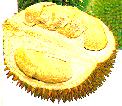
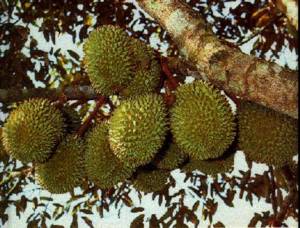
Durians
The durian is believed to be native to Borneo and Sumatra. It is found wild or semi-wild in South Tenasserim, Lower Burma, and around villages in Malaysia, and is commonly cultivated along roads or in orchards from southeastern India and Ceylon to New Guinea. Four hundred years ago, there was a lively trade in durians between Lower Burma to Upper Burma where they were prized in the Royal Palace. Thailand and South Vietnam are important producers of durians. The Association of Durian Growers and Sellers was formed in 1959 to standardize quality and marketing practices. The durian is grown to a limited extent in the southern Philippines, particularly in the Provinces of Mindanao and Sulu. The tree grows splendidly but generally produces few fruits in the Visayas Islands and on the island of Luzon. There are many bearing trees in Zanzibar, a few in Pemba and Hawaii. The durian is not included in the latest Flora of Guam (1970) which covers both indigenous and exotic species. It has been introduced into New Guinea, Tahiti, and Ponape.
The durian is rare in the New World. Seeds from Java were planted at the Federal Experiment Station in Mayaguez, Puerto Rico in 1920. The single resulting tree bloomed heavily in February and March in 1944 but only one fruit matured in July and it had but 3 normal carpels. Nevertheless, there were 6 fully developed seeds which germinated and were planted. The tree has fruited in Dominica and Jamaica. There have been specimens in the Royal Botanic Gardens, Port-au-Spain, Trinidad, for many years though they are not very much at home there. Young trees and seeds were introduced into Honduras from Java in 1926 and 1927, and the trees have grown well at the Lancetilla Experimental Garden at Tela, but they bear poorly to moderately. Seedlings have lived only briefly in southern Florida.
Varieties
Much variation occurs in seedlings. There are over 300 named varieties of durian in Thailand. Only a few of these are in commercial cultivation. In Malaysia, 100 types are graded for size and quality. In Malaysia, there are 44 clones with small differences in time and extent of flowering, floral and fruit morphology, productivity and edible quality.
Season
Malaysia has two fruiting seasons: early, in March and April; late, in September and October. Nearly all cultivars mature within the very short season during which the fruits are present in great numbers in local markets.
The Tree
The durian is a tall tree towering as high as 40m in the jungle rainforest or in semi-orchard. Seed trees may take 8-10 years to fruit. A grafted durian tree assumes a christmas tree habit and grows to 15 - 20m tall. The fruit is green to brown in colour, pendulous, round to oblong in shape and is completely covered with strong sharp thorns. It is a capsule which splits into five parts when ripe and each segment contains brown seeds covered with thick, firm, creamy, yellow pulp with an overpowering aroma. The durian is native to Malaysia and Indonesia. In Malaysia about 50% of the total production is from Johore ,Pahang and Perak.
Keeping Quality
Durians are highly perishable. They are fully ripe 2 to 4 days after falling and lose eating quality in 5 or 6 days.
POPULAR CLONES IN MALAYSIA
| Clone | Popular Name | Origin | Characteristics |
|---|---|---|---|
| D24 | - | Bukit Merah Reservoir, Perak (Malaysia) | It is oval in shape, of average size, weighing between 1 - 2.8kg. per fruit. The skin is green to brownish green and the thorns are sharp and thin. The flesh is yellow, thick and sweet. |
| D99 | Kop | Thailand | The fruit is round and of average size weighing between 1 - 2kg. per fruit. The skin is green to brownish green and the thorns are short and sharp. The flesh is fairly thick yellow, soft and sweet. |
| D123 | Chanee | Thailand | The fruit is oval in shape and big weighing between 2 - 4kg. per fruit. The skin is green to rust colour and the thorns are big. The flesh is golden yellow, thick, soft and sweet. |
| D158 | Kan Yau | Thailand | Average size weighing between 2 - 4kg. per fruit. The skin is brownish green and the fruit is oval in shape and can be as long as 15 - 17cm. The flesh is golden yellow and sweet. |
| D159 | 'Man Thong'/ Golden Pillow | Thailand | The fruit is large and can reach a weight of 4 - 6kg. per fruit. The fruit is long and oval in shape and curves at the end. The thorns are brownish while the flesh is golden yellow, thick and sweet. |
| D169 | - | Kelantan (Malaysia) | Average size fruit between 1 - 2kg. each. Longish oval shape with yellowish green skin and sharp thorns. The flesh is yellow, thick and soft with a bitter sweet taste. |
| D145 | Berserah Durian/ Mek Durian/ Green Durian | Beserah, Kuantan, Pahang (Malaysia) | Average size weighing between 1 - 2kg. per fruit. It is round and nippled at the end. The thorns are long and closely packed and the skin is green. The flesh is golden yellow, soft and Sweet. |
Food Value Per 100 g of Edible Portion
| Item | Fresh Arils | Dried Arils |
| Calories | 144 | - |
| Moisture | 58.0-62.9 g | 18.0 g |
| Protein | 2.5-2.8 g | - |
| Fat | 3.1-3.9 g | 3.0-6.0 g |
| Sugars | (approx.) 12.0 g | 37.0-43.0 g |
| Starch | (approx.) 12.0 g | 8.0-13.0 g |
| Total Carbohydrates | 30.4-34.1 g | - |
| Fiber | 1.7 g | - |
| Ash | 1.1-1.2 g | 3.0 g |
| Calcium | 7.6-9.0 mg | - |
| Phosphorus | 37.8-44.0 mg | - |
| Iron | 0.73-1.0 mg | - |
| Carotene | 0.018 mg | - |
| (as Vitamin A) | 20-30 I.U. | - |
| Thiamine | 0.24-0.352 mg | - |
| Riboflavin | 0.20 mg | - |
| Niacin | 0.683-0.70 mg | - |
| Ascorbic Acid | 23.9-25.0 mg | - |
| Vitamin E | "high" | - |
Toxicity
The seeds are believed to possess a toxic property that causes shortness of breath.
Rind: The dried or half-dried rinds are burned as fuel and fish may be hung in the smoke to acquire a strong flavor. The ash is used to bleach silk.
Wood: The sapwood is white, the heartwood light red-brown, soft, coarse, not durable nor termite-resistant. It is used for masts and interiors of huts in Malaysia.
Medicinal Uses: The flesh is said to serve as a vermifuge. In Malaysia, a decoction of the leaves and roots is prescribed as a febrifuge. The leaf juice is applied on the head of a fever patient. The leaves are employed in medicinal baths for people with jaundice. Decoctions of the leaves and fruits are applied to swellings and skin diseases. The ash of the burned rind is taken after childbirth. The leaves probably contain hydroxy-tryptamines and mustard oils.
The odor of the flesh is believed to be linked to indole compounds which are bacteriostatic. Eating durian is alleged to restore the health of ailing humans and animals. The flesh is widely believed to act as an aphrodisiac. In the late 1920's, Durian Fruit Products, Inc., of New York City, launched a product called "Dur-India" as a "health-food accessory" in tablet form, selling at $9 for a dozen bottles, each containing 63 tablets–a 3-months' supply. The tablets reputedly contained durian and a species of Allium from India, as well as a considerable amount of vitamin E. They were claimed to provide "more concentrated healthful energy in food form than any other product the world affords"–to keep the body vigorous and tireless; the mind alert with faculties undimmed; the spirit youthful.
A toothpaste and condom flavored with durian is currently marketed for durian fanciers.
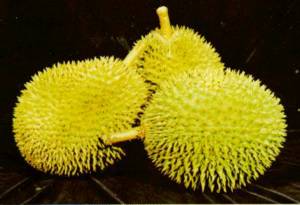
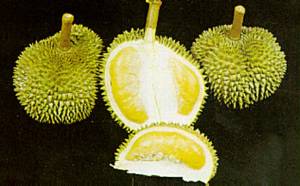
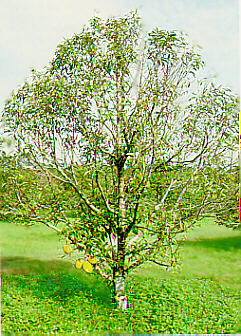






0 Comments:
Post a Comment
<< Home